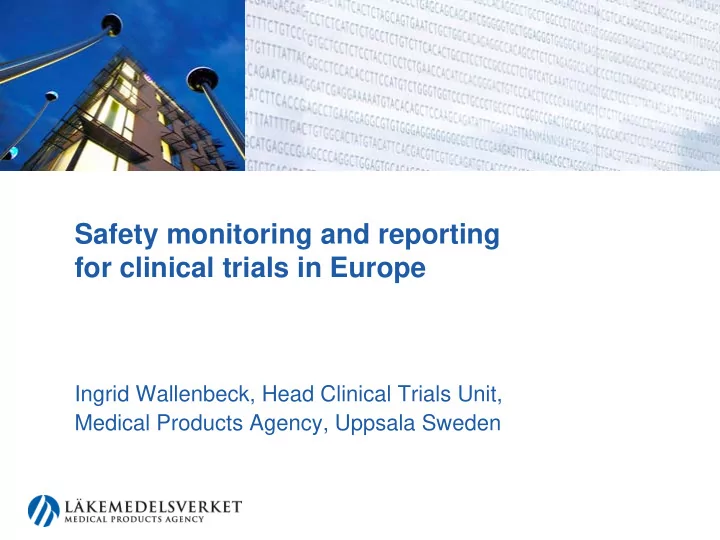

Safety monitoring and reporting for clinical trials in Europe Ingrid Wallenbeck, Head Clinical Trials Unit, Medical Products Agency, Uppsala Sweden
Overview of Safety work • Data from preclinical studies - what is expected and tolerable? • During administration to volunteers or patients - safety measures in study protocol - report whatever is reported or observed - serious- non-serious - serious and expected or serious and unexpected? • Reference Safety Information - Product specific - Investigator Brochure or SPC
Obligations to report During Clinical Studies – Serious Unexpected Serious Adverse Reactions (SUSARs) – Annual SafetyReport (ASR) – New format: Development Safety Update Reports (DSUR For Marketed Prodcts – Periodic Safety Update Reports (PSUR)
Study protocol work To be considered: – Protocol structure according to ICH E6 section 6 – Safety measures in protocol (ICH E6 section 6.8) – Special safety considerations (product related) – Need for data monitoring board – Safety reporting time after treatment termination
To be reported All Adverse Reactions including – Severity (mild, moderate, severe) – Seriousness (serious, non-serious) – Relatedness ( unrelated, possibly related, probably related)
Definition of Adverse Reaction "Any untoward or unfavorable medical occurrence in a clinical research study participant, including any abnormal sign (e.g. abnormal physical exam or laboratory finding), symptom, or disease, temporally associated with the participants’ involvement in the research, whether or not considered related to participation in the research."
Definition of Seriousness Serious if – results in death – is life threatening – requires hospitalisation, or prolongs hospitalisation – results in persistent or significant disability or defect – is a congenital anomaly or birth defect Otherwise non-serious
Severity – Is a different assessment vs. seriousness and relates to intensity of an adverse event Causality / Relatedness – to be reported by investigator Sponsor is responsible to ensure that only SARs with "reasonable causal relationship" are assessed for expectedness and considered for SUSAR reporting
Definition of suspected unexpected vs. expected SARs Definitions: – Expected if included in Reference Safety Information, i.e. previously reported – Unexpected unless included in Reference Safety Information
Blinded Serious Adverse Reactions – Consider importance and consequence of unblinding – Unblinding strongly recomended for SUSARs – Reference is made to ICH E2A section III D
Reporting obligations during study SAR (including SUSAR) reports • Investigator to sponsor – immediate report within 48 hours – follow-up information with details • Sponsor to decide if unexpected (SAR or SUSAR) • Sponsor to report SUSARs to EudraVigilance Clinical Trial Module – within 7 days – follow-up information with details within an additional 8 days
Reporting obligations during study (cont'd) Non-serious adverse events and/or laboratory abnormalities –only if identified as critical safety information in study protocol –to be reported by investigator to sponsor
After study termination • Study Report to NCA within 12 months – Study report summary including main efficacy and safety results is sufficient – Within 6 months if paeditric population
During development (if any study ongoing) Annual Safety Report – An annual summary of all serious adverse events for an active compound in clinical evaluation with a safety evaluation relating to the ongoing study (ies) – New upcoming format: DSUR Update Investigator’s brochure (IB) – At least once per year according to Good Clinical Practice – Include any relevant new (including safety related) data on IMP
Eudravigilance database Set up for pharmacovigilance activities in the pre- and post- authorisation phase with two reporting modules: –The EudraVigilance Clinical Trial Module (EVCTM) for electronic reporting of (SUSARs) as required by Directive 2001/20/EC –The EudraVigilance Post-Authorisation Module (EVPM) designed for post- authorisation Individual Case Summary Reports In preparation of training and reporting: http://eudravigilance.emea.europa.eu/human/TenSteps.asp http://eudravigilance.emea.europa.eu/human/training.asp
How to report to Eudravigilance CTM Sponsor has overall responsibility for reporting, including time frame –in house reporting preferred –can delegate to Contract Research Organisation
Conclusions Sponsor has ultimate responsibility for patient safety in clinical studies CAs focus on patient safety in clinical trial assessment –Secure regulatory competence for development plans –Familiarise with safety monitoring and reporting demands
Recommend
More recommend